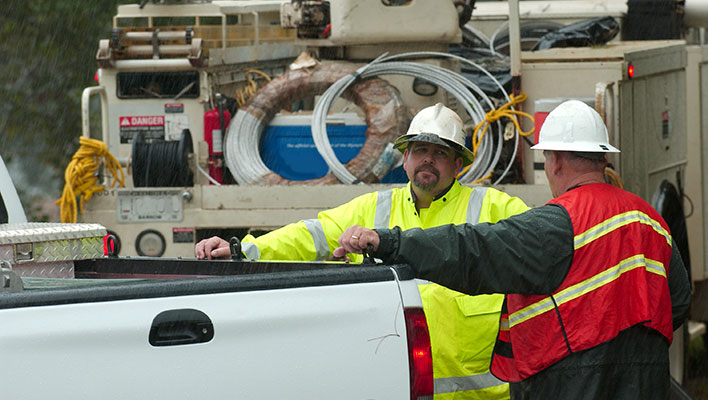With more than 30 years of experience with a leading investor owned utility, Jamie Conover brings a valuable perspective to the ARCOS blog. Drawing on his extensive background in technical performance, optimization, and incident command for electric transmission, distribution, and natural gas operations, he offers strategies to increase business agility and hit moving business targets amidst shifting workforce dynamics and climate change that is leading to more frequent and severe outages.
As a career utilities professional with 34 years of experience working at the same utility company, I’ve had the opportunity to contribute to many business functions, including generation, transmission, distribution and compliance. This perspective allows me to speak to the competing pressures shaping the future of our industry, whether that’s meeting expanding systems to meet escalating demand or responding to the effects of climate change by getting the lights back on following outages from stronger storms, flooding, and wildfires (the topic of my last post). Touching every facet of power utilities though is not only an increasing reliance on contractors, but an entirely new world view from the new, younger generation that makes my lifelong career at one of the country’s top 10 utilities less and less common.
A Younger Generation is Taking Over the Lines
Utilities across the country must manage more routine and unplanned work with a shrinking workforce as senior linemen retire and are replaced with fewer full time junior workers. Those that do sign on for a stint at a utility do so for about as long as it takes to make journeyman before quitting and then appearing on the roster at a contractor company. Utilities are now where new line workers go to get trained for their full-time contract career.
The good news is that younger line workers are entering the field, but they are attracted to the higher pay of a contractor. The contract lifestyle is also attractive to the new generation who don’t think in terms of a career as the older generation did and who value flexibility to work a gig, travel, and take long breaks, all of which being a contractor provides. A contractor heavy hybrid workforce is the new reality.
Contractors offer electric providers many benefits, including the ability to scale up and scale down as needed for routine work and, of course, force multiply storm response with large scale mutual assistance. How contractors are integrated into the utility workforce of the future is a strategic advantage that will dictate how well a utility meets blue or red sky challenges.
Managing Tomorrow’s Challenges with the Tools of the Past
Many contractors don’t have direct access to the information systems and mobile workforce management technology of the utility’s full-time employees. Security is certainly a primary argument but that’s not the root of the problem. The fact is that the systems that most utilities deploy today to manage their mobile workforce were designed at a time when that workforce was largely full-time employees with few contractors. We are managing today’s hybrid workforce challenges with the tools of the past. An unavoidable result is that contractors are cut out of the information loop, leading to processes that are heavy on paperwork packets, lack transparency or accountability, and require multiple phone calls to coordinate jobs.
With all that utilities must accomplish today expanding systems and responding to outages from more frequent and severe natural disasters, the tools and processes of the past must be replaced with new technology that allows the utility to treat contractors more like their own.
Integrating Contractors into a Seamless, Hybrid Workforce
Business automation is the path teams can take to greater agility and more effective hybrid workforce management. For full time employees, this starts with a solution like ARCOS Crew Manager. It does not replace other systems that utilities also rely on to manage their field workers. Crew Manager allows a utility to leverage existing investments in WMS and OMS by accessing these systems in place using an API (application programming interface). This instantly eliminates siloed information and data delays and allows back-office teams to drag, drop, and assign crews, work, and assets based on their current availability and proximity to blue or red sky jobs.
Complementing internal crew management with external resource management is ARCOS Resource Assist, which rapidly mobilizes an entire hybrid workforce with tools to find, schedule, and integrate contractors. It automates the process of reaching out to large numbers of contractors, verifying availability, and integrating committed external resources into other ARCOS solutions that can track them alongside work and assets.
With 60% full time employees, my utility is one of the few places in the country where career workers outnumber contractors. While we currently rely on Crew Manager, we have not needed to rely on Resource Assist, but that is changing. Anticipating the big crew change to continue and that we must collaborate with an increasing pool of contractors’ in the future, my team and I are already paving the way to extend digital workforce management to external resources.
Change is often met with resistance at first until technology is understood. There’s also an assumption that contractors don’t want utilities to force their technology upon them. Ease of use is key and app developers like ARCOS truly understand that which is why they ride shotgun with crews to get the user experience just right. Where I work, we are also hedging our bets by using Resource Assist starting with contractors who are already familiar with ARCOS, enabling us to start small and scale big.
Technologies like Resource Assist are essential to effective hybrid workforce management, from accelerating capital construction projects to responding more effectively and with better coordination during outages. Power utilities also have an opportunity to get ahead of the game when it comes to the level of outages we can expect in the future as climate change alters weather patterns. Increasingly, best-in-class outage response will include standards for an Incident Command Structure as well.
I’ll share my thoughts on ICS and how my team is approaching it in my next and final blog in this series where I’ve hopefully added value around the different ways utilities can increase their workforce agility. Thanks for reading along the way and please feel free to reach out with any questions.
Did you enjoy Jamie’s blog? Check out his previous post: Pivoting from Blue to Dark Sky Work





